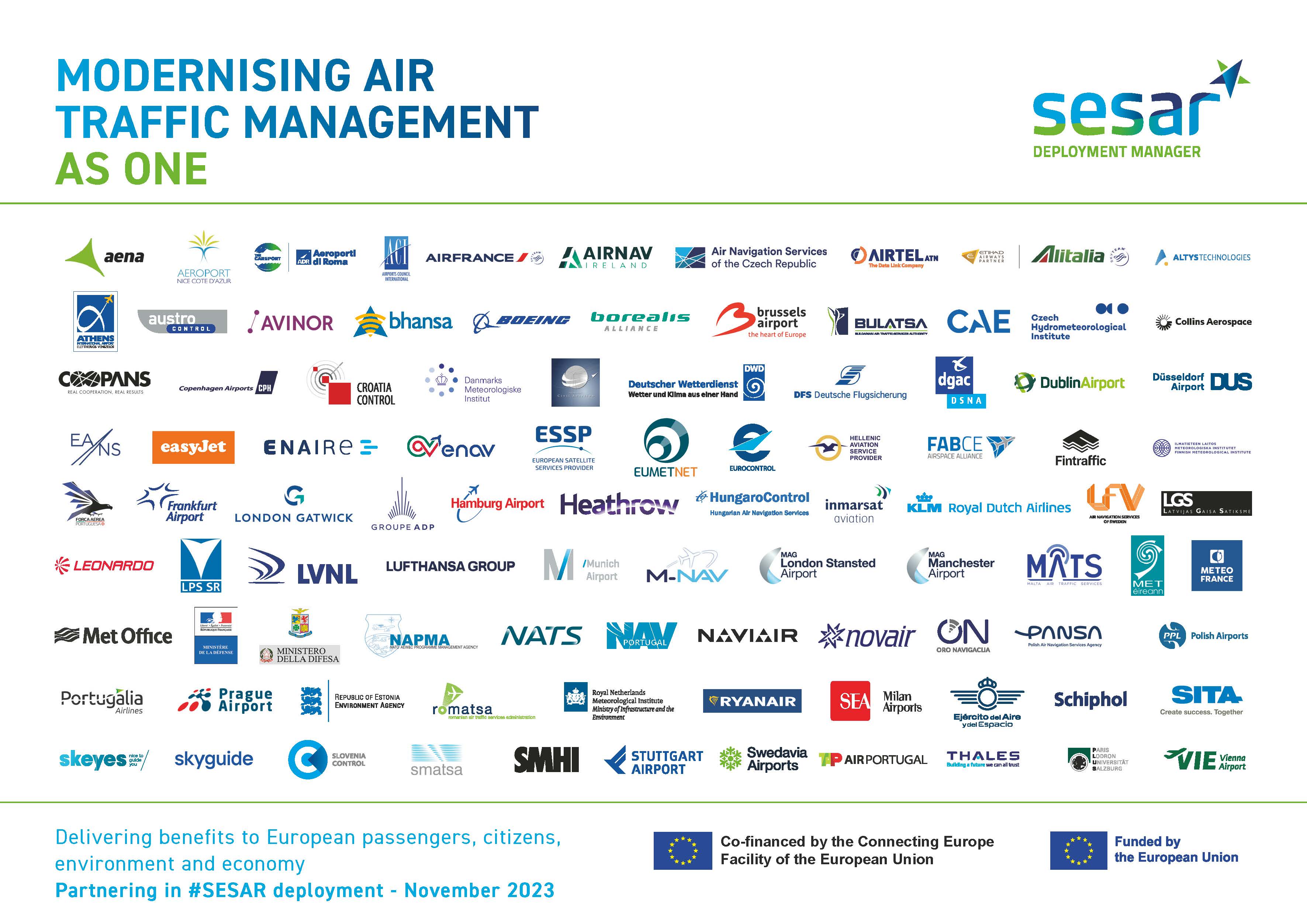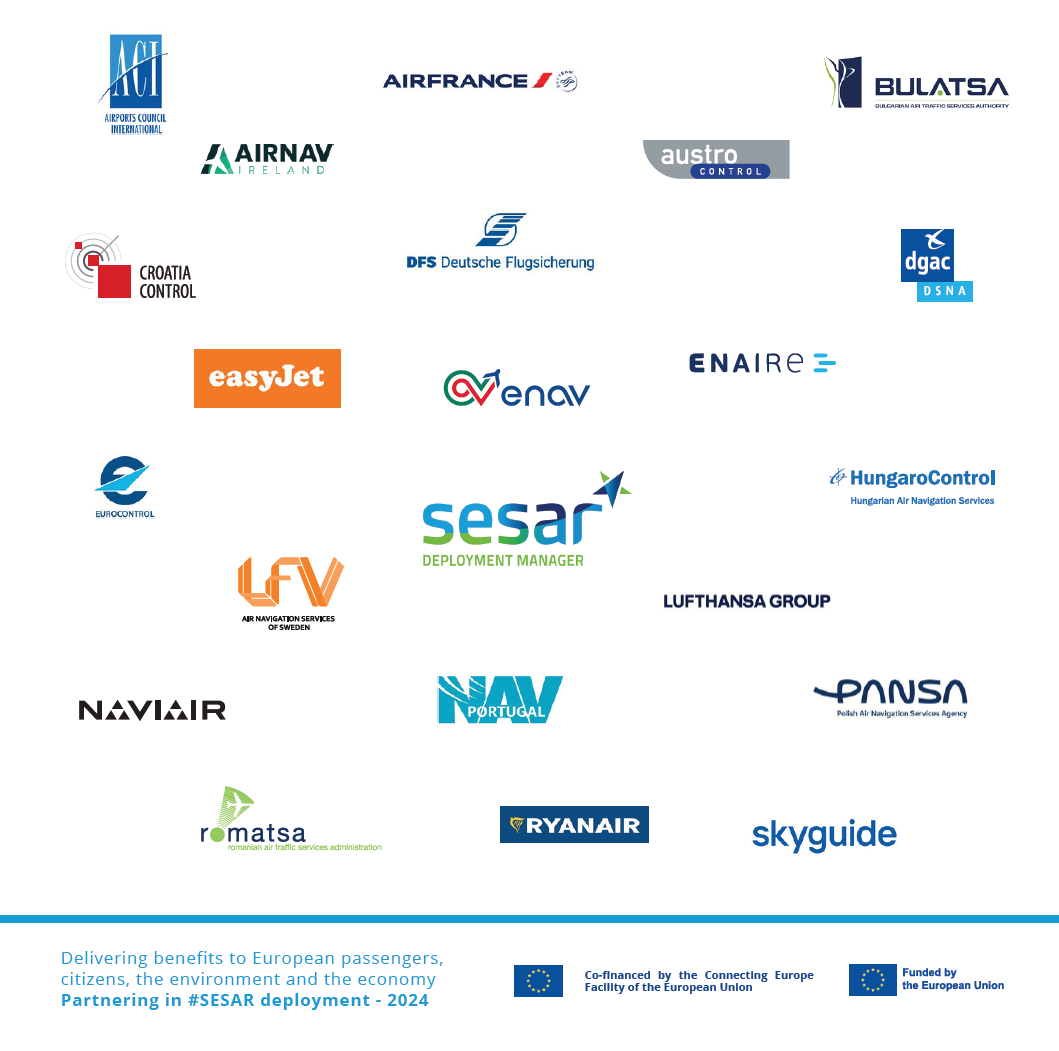About the SESAR Deployment Manager
Modernising Europe’s Air Traffic Management
Why modernise Europe’s Air Traffic Management?
The modernisation of Europe’s Air Traffic Management (ATM) networks is crucial for the sustainability of European aviation and the forecasted increase in air traffic by 2035. The Single European Sky (SES) ATM research project, “SESAR”, is one of the most ambitious modernisation projects launched by the European Union contributing to the implementation of SES.
SESAR’s goal is to define, develop, and deploy the technological solutions needed to increase the performance of Europe’s ATM system, and consists of three main phases:
Definition
The European ATM Master Plan is the roadmap for driving the European ATM modernisation programme, managed by the SESAR Joint Undertaking (SJU). It sets out the necessary steps involved for the identification, the development, the validation and deployment of SESAR Solutions with technologies and operational procedures, linking them to the Single European Sky performance objectives and ensuring global interoperability and consistency with the ICAO Global Air Navigation Plan.
Development
The SESAR Joint Undertaking (SJU), established end of 2007, is responsible for research and development required for the modernization of the European ATM system by coordinating and concentrating all relevant efforts in the EU. It is a public-private partnership (PPP) between the European Union – represented by the European Commission – and Eurocontrol (the founding members) and industrial European ATM stakeholders.
Deployment
The SESAR Deployment Manager (SDM), established end 2014, came as the natural sequence of the SJU. Under the oversight of the Policy Level led by the European Commission, it is responsible for the Management Level of the SESAR deployment governance, for the coordination of the implementation of the most essential SESAR operational improvements through the concept of Common Projects. A Common Project is an extraction from the European ATM Master Plan, based on mature SESAR Solutions to be deployed in a synchronized and timely manner across Europe, translated into an European Law. Whilst the European ATM Master Plan is indicative, a Common Project binds the Member States of the European Union and their operational stakeholders.
About SESAR Deployment Manager Function
The SESAR Deployment Manager function
The SESAR Deployment Manager (SDM) function is defined by the Article 9 of Commission Implementing Regulation (EU) N°409/2013. Under the oversight of the European Commission, the SDM function consists of the synchronisation and the coordination of the deployment of the Common Projects. A Common Project is a Commission Implementing Regulation which mandates the implementation of the most essential operational changes in the European ATM Master Plan by the Member States of the European Union and their operational stakeholders. The first Common Project is known as the Pilot Common Project (PCP) and is defined by the Regulation (EU) N°716/2014. The SDM synchronises and coordinates implementation against the SESAR Deployment Programme which is a project view of the Common Projects organising their implementation into optimum sequences of activities by all the stakeholders required to implement. To develop and maintain the SESAR Deployment Programme in close consultation with all the stakeholders is another important task under the SDM function.
More than nine years after the beginning of this deployment phase in 2014, the modernisation and digitalization of the European ATM systems and infrastructure is a growing operational reality with 317 projects in operation and 39 ongoing (update February 2025). More importantly, it is delivering its expected performance benefits to the aviation community, its stakeholders and in turn to European passengers, citizens, economy and environment benefitting the #EUGreenDeal.
On 02/02/2021, the Common Project One or CP1 regulation was published, ensuring a smooth continuation of sustainable Air Traffic Management modernisation and digitalization through SESAR deployment.
SESAR Deployment Implementing Partners

About SESAR Deployment & Infrastructure Partnership
The SESAR Deployment & Infrastructure Partnership

The SESAR Deployment & Infrastructure Partnership (SDIP) is the organization which has been selected by the European Commission on 01/06/2022 to perform the SDM function until 2027.
Governance
SDIP is led by Mariagrazia La Piscopia as the Executive Director supported by the Management Team and under the oversight of the Supervisory Board and the European Commission. You can find details of all members of the Management Team on our contact page.
The Executive Director is appointed by and reports to the Supervisory Board, materialising the equal partnership between the Airlines, Airports, Air navigation service providers and EUROCONTROL/ Network Manager.
The governance is driven by the SDIP members, representing a large majority on all fronts in European ATM/aviation (see also the overview above):
Airlines:
Air France, easyJet Europe, Lufthansa and Ryanair are amongst the major airlines operating in the European Union, as they perform over 3 million flights and fly over 500 million passengers per year under normal traffic conditions, at least one third of the overall European passengers.
Airports:
ACI Europe represents over 530 airports spanning across 55 European countries, including all major airports mentioned in the text of Common Project One and that will be likely subject to any future Common Projects.
Air Navigation Service Providers:
The 15 Air Navigation Service Providers participating to the Consortium (the COOPANS Alliance (i.e., Austrocontrol, Croatia Control, LFV, IAA, Naviair, NAV Portugal), BULATSA, DSNA, DFS, ENAIRE, ENAV, HungaroControl, PANSA, ROMATSA and Skyguide) are responsible for controlling around 80% of the traffic volume operated in the European Union area, which is equivalent to around 8 million flights per year, under normal traffic conditions.
The Network Manager:
The European Union first established the Network Manager (NM) under the Single European Sky (SES) II package agreed in 2009 to perform the tasks necessary for the execution of the network functions. In 2019, the Commission re-appointed EUROCONTROL as the Network Manager for the period 2020-2029 through its Implementing Decision 2019/709. A new Implementation Regulation was adopted in 2019 (Network Function Implementation Regulation 123/2019), which entered into force on 1 January 2020 and which regulates the activities of the Network Manager.